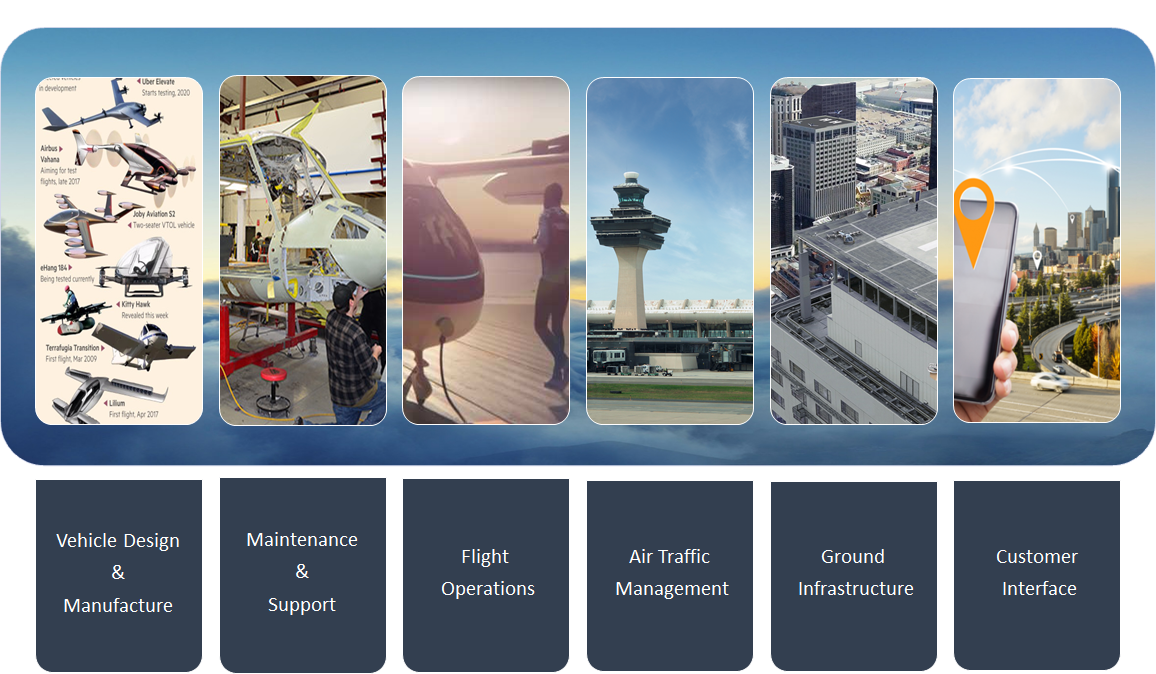Urban Air Mobility – Industry Landscape
The Urban Air Mobility (UAM) ecosystem is growing rapidly as new companies begin to emerge from their development stages into full operations. In this vast network, there are many products and services being introduced into the market and although it may seem overwhelming at first, once we dive into the UAM industry landscape overview, it becomes apparent that it very much looks like our current aviation industry. As such, Vehicle Design & Manufacture, Support & Services, Flight Operations, Air Traffic Management, Ground Infrastructure, and Customer Interface are the main elements that make up the UAM ecosystem.

Vehicle Design & Manufacture
Similar to the big players like Boeing and Airbus in the commercial aircraft industry, many companies in the urban air mobility industry are in the race to become the leaders of the urban aircraft. This group consists of all Original Equipment Manufacturers (OEM) involved in the design, development and production of vehicles that will eventually serve our skies. Evidently the big names mentioned above are among the current OEMs building and flight testing urban aircraft, however many others such as eHang, Lilium, Volocopter, Bell, Kittyhawk and Workhorse are well positioned and determined to be a major producer for the industry as well.



This business sector also includes the design and certification bodies that are sometimes separate from the OEM and provide the all important type design services. Obtaining certification with the regulators is often challenging and these design companies help facilitate this process.
Maintenance & Support
Once the vehicle is approved and certified to fly it is acquired by operators to serve its intended design purposes. However, these operations cannot function without proper support and serviceability. As with the current aviation industry, maintenance service facilities are essential to the flight operators. Maintenance, Repair & Overhaul (MRO) companies provide full support to aircraft fleet and are also required to maintain flight airworthiness. Although this can be part of the operators’ business functions, most often we see as a separate entity. In any case, the support for aircraft maintenance and spare parts makes up this sector for commercial aviation and will certainly be the same for personal air vehicles and air taxis within the urban air mobility ecosystem.
Flight Operations
Operating, leasing, acquiring, and flying urban aircraft can be compared to the air chartering and commercial carriers of aviation today. Although the urban air taxi business will be much more complex due to congested airspace, and autonomous flight, much of the flight operations business structure will look similar to today. Acquiring fleets of aircraft and obtaining an Operating Certificate (OC) in order to commercialize urban air traffic, will be just the beginning for these companies. The flight operators find themselves in the middle of the entire ecosystem dealing with all elements of the industry from OEMs, MROs, FBOs, ATC, and finally the end user – the passengers!


Air Traffic Management
The business sector will consist of all companies developing and operating ATM solutions for urban aircraft. Already with its own challenges, the complexity of introducing new vehicles in the sky such as drones, air taxis, and personal air vehicles, will further test the ATM network. With several factors like weather, autonomous flight, and highly congested airspace, managing the skies for safety and security will become paramount. Organizations not only this business sector, but across the entire UAM ecosystem will need to be working in collaboration to ensure full harmonization.

Ground Infrastructure
Think of the airports and helipads of today and expand this network into the urban areas. Installation and maintenance of these new landing zones will be governed by companies in the ground infrastructure sector. Municipalities and local businesses will make up a large part of this network, however they must work closely with the Flight Operators to ensure all requirements are adhere to and properly managed for successful and safe operations. According to experts like Andreas Thellman at Airbus, this ground infrastructure network is the secret bottle neck in the urban air mobility industry.


Customer Interface
With Uber and NASA teaming up to further explore concepts and technologies related to urban air mobility, there is a large community of expert working towards ensuring a safe and efficient system for future air transportation in populated areas. Inevitably customer interface apps similar to Uber and VOOM today will be our means of booking such air taxis in the future. However, unifying the different futures of transportation is a complex network of companies and technologies such as Mobility as a Service (MaaS), personalized routing, public transportation, and many other applications facilitating the booking and coordination of urban travel.



